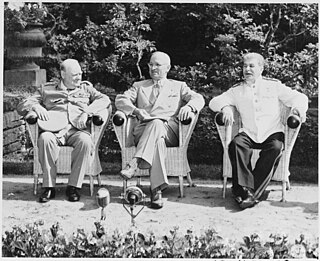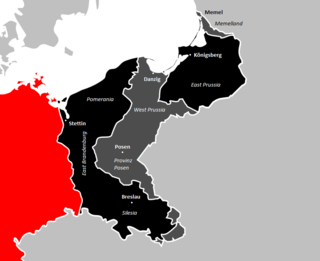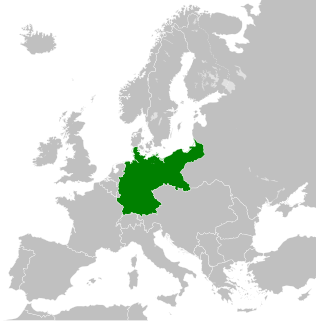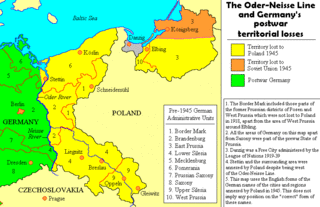
The Potsdam Conference was held at Cecilienhof, the home of Crown Prince Wilhelm in Potsdam, occupied Germany, from 17 July to 2 August 1945. The participants were the Soviet Union, the United Kingdom, and the United States, represented respectively by Communist Party General Secretary Joseph Stalin, Prime Ministers Winston Churchill and Clement Attlee, and President Harry S. Truman.

The Potsdam Agreement was the August 1945 agreement between three of the Allies of World War II, the United Kingdom, the United States, and the Soviet Union. It concerned the military occupation and reconstruction of Germany, its borders, and the entire European Theatre of War territory. It also addressed Germany's demilitarisation, reparations and the prosecution of war criminals.

The Battle of Tannenberg was fought between Russia and Germany between the 26th and 30th of August 1914, the first month of World War I. The battle resulted in the almost complete destruction of the Russian Second Army and the suicide of its commanding general, Alexander Samsonov. A series of follow-up battles destroyed most of the First Army as well and kept the Russians off balance until the spring of 1915. The battle is particularly notable for fast rail movements by the Germans, enabling them to concentrate against each of the two Russian armies in turn, and also for the failure of the Russians to encode their radio messages. It brought considerable prestige to Field Marshal Paul von Hindenburg and his rising staff-officer Erich Ludendorff.

East Prussia was a province of the Kingdom of Prussia from 1773 to 1829 and again from 1878 ; following World War I it formed part of the Weimar Republic's Free State of Prussia, until 1945. Its capital city was Königsberg. East Prussia was the main part of the region of Prussia along the southeastern Baltic Coast.

The Tehran Conference was a strategy meeting of Joseph Stalin, Franklin D. Roosevelt, and Winston Churchill from 28 November to 1 December 1943, after the Anglo-Soviet Invasion of Iran. It was held in the Soviet Union's embassy in Tehran, Iran. It was the first of the World War II conferences of the "Big Three" Allied leaders. It closely followed the Cairo Conference which had taken place on 22–26 November 1943, and preceded the 1945 Yalta and Potsdam conferences. Although the three leaders arrived with differing objectives, the main outcome of the Tehran Conference was the Western Allies' commitment to open a second front against Nazi Germany. The conference also addressed the 'Big Three' Allies' relations with Turkey and Iran, operations in Yugoslavia and against Japan, and the envisaged post-war settlement. A separate protocol signed at the conference pledged the Big Three to recognize Iran's independence.

The Yalta Conference, also known as the Crimea Conference and code-named the Argonaut Conference, held from 4 to 11 February 1945, was the World War II meeting of the heads of government of the United States, the United Kingdom and the Soviet Union for the purpose of discussing Germany and Europe's postwar reorganization. The three states were represented by President Franklin D. Roosevelt, Prime Minister Winston Churchill and Premier Joseph Stalin, respectively. The conference convened near Yalta in Crimea, Soviet Union, within the Livadia, Yusupov, and Vorontsov Palaces.
The European Theater of Operations, United States Army (ETOUSA) was a United States Army formation which directed US Army operations in parts of Europe from 1942 to 1945. It referred to Army Ground Forces, United States Army Air Forces, and Army Service Forces operations north of Italy and the Mediterranean coast, in the European Theater of World War II. It was bordered to the south by the North African Theater of Operations, US Army (NATOUSA), which later became the Mediterranean Theater of Operations (MTOUSA).

The Kingdom of Prussia was a German kingdom that constituted the state of Prussia between 1701 and 1918. It was the driving force behind the unification of Germany in 1871 and was the leading state of the German Empire until its dissolution in 1918. Although it took its name from the region called Prussia, it was based in the Margraviate of Brandenburg, where its capital was Berlin.

The Morgenthau Plan by the Allied occupation of Germany following World War II was a proposal to eliminate Germany's ability to wage war by eliminating its arms industry, and the removal or destruction of other key industries basic to military strength. This included the removal or destruction of all industrial plants and equipment in the Ruhr. It was first proposed by United States Secretary of the Treasury Henry Morgenthau Jr. in a memorandum entitled Suggested Post-Surrender Program for Germany.

The Invasion of Poland, known in Poland as the September Campaign or the 1939 Defensive War, and in Germany as the Poland Campaign (Polenfeldzug), was an invasion of Poland by Germany that marked the beginning of World War II. The German invasion began on 1 September 1939, one week after the signing of the Molotov–Ribbentrop Pact between Germany and the Soviet Union. The Soviets invaded Poland on 17 September following the Molotov–Tōgō agreement that terminated the Soviet and Japanese Battles of Khalkhin Gol in the east on 16 September. The campaign ended on 6 October with Germany and the Soviet Union dividing and annexing the whole of Poland under the terms of the German–Soviet Frontier Treaty.

Prussia was a historically prominent German state that originated in 1525 with a duchy centred on the region of Prussia on the southeast coast of the Baltic Sea. It was de facto dissolved by an emergency decree transferring powers of the Prussian government to German Chancellor Franz von Papen in 1932 and de jure by an Allied decree in 1947. For centuries, the House of Hohenzollern ruled Prussia, successfully expanding its size by way of an unusually well-organised and effective army. Prussia, with its capital in Königsberg and from 1701 in Berlin, decisively shaped the history of Germany.

The Province of Silesia was a province of Prussia from 1815 to 1919. The Silesia region was part of the Prussian realm since 1740 and established as an official province in 1815, then became part of the German Empire in 1871. In 1919, as part of the Free State of Prussia within Weimar Germany, Silesia was divided into the provinces of Upper Silesia and Lower Silesia. Silesia was reunified briefly from 1938 to 1941 as a province of Nazi Germany before being divided back into Upper Silesia and Lower Silesia.

The Province of Hohenzollern or the Hohenzollern Lands was a province of Prussia from 1850 to 1946.

The former eastern territories of Germany are those provinces or regions east of the current eastern border of Germany which were lost by Germany after World War I and then World War II.

Gołdap is a town and the seat of Gołdap County in the Warmian-Masurian Voivodeship in Poland. It is located on the Gołdapa River, between the Szeskie Hills and the Puszcza Romincka forest. It has a population of 15,600. Its coat of arms depicts the House of Hohenzollern and Brandenburg.

The Casablanca Conference was held at the Anfa Hotel in Casablanca, French Morocco, from January 14 to 24, 1943, to plan the Allied European strategy for the next phase of World War II. In attendance were United States President Franklin D. Roosevelt and British prime minister Winston Churchill. Also attending and representing the Free French forces were Generals Charles de Gaulle and Henri Giraud, though they played minor roles and were not part of the military planning. Premier Joseph Stalin had declined to attend, citing the ongoing Battle of Stalingrad as requiring his presence in the Soviet Union.

The territorial changes of Germany include all changes in the borders and territory of Germany from its formation in 1871 to the present. Modern Germany was formed in 1871 when Otto von Bismarck unified most of the German states, with the notable exception of Austria, into the German Empire. After the First World War, Germany lost about 10% of its territory to its neighbours and the Weimar Republic was formed. This republic included territories to the east of today's German borders.

Berlinka is the informal Polish and Russian name given to sections of the unfinished Reichsautobahn Berlin-Königsberg, which was a pre-World War II German Reichsautobahn project to connect Berlin with Königsberg in East Prussia. In the late 1930s, the sections near these two cities were finished, but not the larger section in between. The German demand in 1939 to run this road across the Polish Corridor with extraterritorial status and Poland's refusal to allow this was an important element in the tensions that led to the start of World War II. After the war, the German Democratic Republic, the People's Republic of Poland and the Soviet Union's Kaliningrad Oblast inherited the remnants.

The Invalidenstraße is a street in Berlin, Germany. It runs east to west for 3 kilometers (1.9 mi) through the districts of Mitte and Moabit. The street originally connected three important railway stations in the northern city centre: the Stettiner Bahnhof, the Hamburger Bahnhof and the Lehrter Bahnhof, the present-day Berlin Hauptbahnhof.

The Oder–Neisse line is the basis of the international border between Germany and Poland. It runs mainly along the Oder and Lusatian Neisse rivers and meets the Baltic Sea in the north, just west of the ports of Szczecin and Świnoujście.























